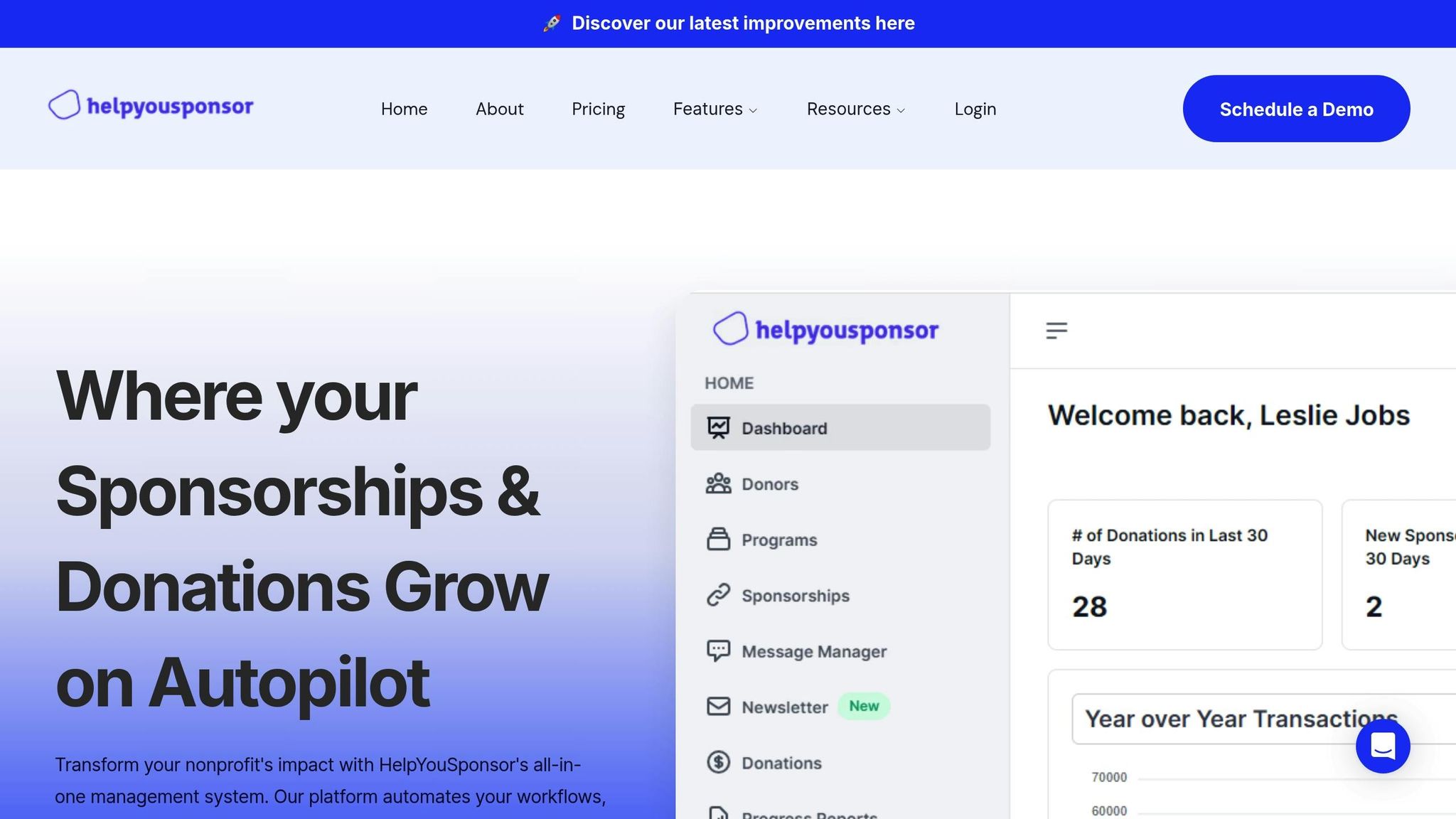Why Storytelling Matters in Peer-to-Peer Fundraising
Explore how storytelling enhances peer-to-peer fundraising by creating emotional connections and motivating donor engagement.

Storytelling is a game-changer in peer-to-peer fundraising. It builds emotional connections, motivates donors, and strengthens long-term support. By sharing personal stories combined with measurable outcomes, nonprofits create a sense of empathy and urgency that drives action.
Key Takeaways:
- Emotional Impact: Stories make causes relatable and inspire donors to act.
- Donor Retention: Nonprofits using storytelling see better engagement and loyalty.
- Practical Tips: Gather real stories, use photos/videos, and maintain consistent messaging across platforms.
Platforms like HelpYouSponsor streamline storytelling by combining donor data and campaign tools, making it easier to connect with supporters and highlight the difference their contributions make.
[Webinar] The power of peer-to-peer: Rally your community to create a movement
Research Findings: How Storytelling Affects Donor Engagement
Studies reveal that blending personal stories with measurable results significantly boosts donor involvement and motivates contributions. These findings shed light on the psychological dynamics that drive donor engagement.
The Psychology Behind Storytelling
Storytelling works because it creates an emotional connection between donors and the cause. When campaigns share personal stories, they showcase the real-life effects of every donation. This approach fosters empathy and helps donors see themselves in the shoes of those they’re helping, making the cause feel urgent and relatable. For instance, focusing on the journey of a single individual in need often resonates more deeply than presenting a list of statistics.
Data That Proves Storytelling Works
More nonprofit leaders are recognizing the value of combining heartfelt narratives with concrete, measurable outcomes. This approach aligns with their focus on donor retention, highlighting how data-driven storytelling can nurture long-term engagement.
Case Studies: Effective Storytelling in Peer-to-Peer Campaigns
Examples from successful campaigns show how combining emotional storytelling with concrete impact data can influence donor behavior and strengthen connections. Insights from U.S.-based campaigns highlight how this approach works in practice.
U.S.-Based Campaign Success Stories
Child sponsorship programs in the U.S. demonstrate that weaving emotional stories with measurable results motivates donors to take action. Medical campaigns thrive by sharing treatment journeys, paired with clear cost breakdowns. Similarly, educational campaigns succeed by providing consistent updates on students' progress.
For instance, some campaigns regularly update donors by showcasing improvements in sponsored children’s education or health, breaking down treatment costs in medical cases, or tracking students' achievements over time. These updates give donors clear, tangible evidence of their contributions making a difference.
These examples underscore the essential components that make fundraising narratives effective.
Key Elements of Effective Fundraising Stories
The most impactful peer-to-peer fundraising stories focus on individual experiences, creating a strong personal connection. By combining heartfelt narratives with clear, measurable results, campaigns make a persuasive case for support. Regular updates and open communication play a vital role in keeping donors engaged and building long-term relationships.
Practical Storytelling Methods for Fundraising Success
Peer-to-peer fundraising thrives when backed by clear and relatable storytelling. To make a real impact, it’s essential to gather genuine stories, enhance them with visuals, and ensure they remain consistent across all communication channels. Here’s how nonprofits can approach storytelling to drive engagement and support.
Finding Real Stories
Some of the best stories come directly from the people impacted by your work - beneficiaries, volunteers, and community members. To uncover these narratives, nonprofits should create straightforward protocols for collecting stories, including obtaining informed consent. Staff members are also a great resource, as their experiences often highlight powerful moments that demonstrate the organization's impact.
Using Photos and Videos to Strengthen Stories
Visuals can bring stories to life and make them far more engaging. Photos and videos that capture authentic, unscripted moments tend to resonate the most. Instead of overly polished or staged imagery, focus on genuine expressions and interactions. At the same time, it’s important to respect privacy and adhere to any guidelines regarding personal or cultural boundaries. Thoughtfully chosen visuals can amplify the emotional connection between your audience and your cause.
Keeping Stories Consistent Across All Channels
Consistency is key when sharing stories across platforms like websites, emails, social media, and live events. To achieve this, nonprofits should establish clear messaging guidelines and maintain a centralized library of approved stories. This ensures that no matter where or how the story is shared, the message stays aligned and reinforces the organization’s mission effectively.
How HelpYouSponsor Supports Storytelling in Peer-to-Peer Fundraising

HelpYouSponsor offers an all-in-one donor management platform that helps nonprofits weave compelling stories into their peer-to-peer fundraising efforts. By bringing together donor data and campaign tracking in one place, it becomes easier to create and share meaningful narratives that connect with supporters. Let’s explore how its features can strengthen your storytelling approach.
Centralized Donor Management
HelpYouSponsor simplifies donor management by consolidating all donor information and activity tracking into a single platform. This makes it easier for nonprofits to analyze donation trends and understand what drives their supporters - an essential step, especially as 62% of nonprofit leaders in 2025 focus on improving donor retention. Plus, having everything in one place streamlines the process of sharing campaign stories with donors.
Built-in Tools for Story Sharing
With integrated messaging and website tools, HelpYouSponsor allows nonprofits to showcase their campaign stories directly on their websites. Automated features like targeted email campaigns and personalized thank-you notes ensure that these narratives reach donors at just the right time, helping to build stronger connections and inspire continued support.
Reporting and Data for U.S. Nonprofits
HelpYouSponsor’s reporting tools are designed with U.S. nonprofits in mind, using familiar formats like MM/DD/YYYY dates, dollar symbols, and comma-separated numbers. These tools make it simple to track donation patterns and measure donor engagement, providing clear updates for board members and stakeholders.
Additionally, the platform integrates seamlessly with payment gateways, offering real-time insights into donations tied to specific campaigns. This data-driven approach not only helps refine storytelling strategies but also boosts the effectiveness of peer-to-peer fundraising initiatives.
Conclusion: Using the Power of Storytelling
Storytelling has the unique ability to strengthen peer-to-peer fundraising by creating genuine connections that inspire ongoing support. Research highlights that blending emotional stories with measurable outcomes forms a strong base for engaging donors and boosting campaign success.
When emotional narratives are paired with clear, concrete data, they not only foster loyalty but also motivate action. Supporters are more likely to give generously - and stay committed - when they can feel the emotional pull of your cause and see the real-world impact of their contributions. This approach speaks to both the heart and the mind, appealing to a range of donor motivations.
With 62% of nonprofit leaders focusing on donor retention in 2025, consistent and heartfelt storytelling becomes a key strategy. Stories have the power to turn one-time donors into lifelong advocates for your mission.
Taking a structured approach to storytelling - gathering real-life accounts, ensuring consistent messaging, and using data to refine your strategy - leads to stronger results. Successful U.S.-based campaigns show that organizations prioritizing storytelling as a core strategy achieve the best outcomes in their peer-to-peer efforts.
Platforms like HelpYouSponsor simplify this process by combining story management with donor tracking, offering tools to integrate storytelling seamlessly into your fundraising operations. This allows you to focus on what matters most: building authentic connections that inspire meaningful support for your mission. When narratives and data work hand-in-hand, the impact of storytelling in peer-to-peer fundraising becomes undeniable.
The takeaway is clear: storytelling isn’t just an extra layer in peer-to-peer fundraising - it’s the foundation that transforms campaigns from simple donation requests into meaningful relationships that benefit your organization and the communities you serve.
FAQs
How can nonprofits collect and use personal stories to boost peer-to-peer fundraising campaigns?
Nonprofits can collect personal stories by connecting with beneficiaries, volunteers, and supporters using methods like surveys, interviews, or online forms. Focus on gathering stories that feel genuine, relatable, and stir emotions - these are the kinds of narratives that can truly connect with potential donors.
After collecting these stories, share them across platforms such as social media, email campaigns, or fundraising pages. These heartfelt accounts can inspire action and build trust. Leveraging tools specifically designed for storytelling and donor engagement can amplify the impact of these narratives, encouraging more donor participation and boosting campaign success.
How can photos and videos strengthen storytelling in fundraising, and what should nonprofits keep in mind when using them?
Photos and videos have an incredible way of bringing stories to life, making them more engaging and emotionally impactful. They allow donors to connect on a deeper, more personal level with a cause, often inspiring greater involvement and generosity. This emotional connection is particularly influential in peer-to-peer fundraising, where heartfelt visuals can be the driving force behind action.
To make the most of visuals, nonprofits should prioritize high-quality content that aligns with the campaign’s message and core values. It’s equally important to secure proper consent from anyone featured in the visuals and ensure the material is both respectful and culturally considerate. Taking these steps not only strengthens trust with donors but also preserves the integrity of your organization’s storytelling efforts.
How does HelpYouSponsor help nonprofits use storytelling in peer-to-peer fundraising campaigns?
HelpYouSponsor makes it easier for nonprofits to weave storytelling into their peer-to-peer fundraising efforts. The platform provides simple tools to build engaging campaign pages, share powerful donor stories, and spotlight the journeys of individual fundraisers. This helps organizations form deeper emotional connections with their supporters.
With an easy-to-use interface and flexible customization options, HelpYouSponsor allows nonprofits to share real, meaningful stories that resonate with donors. This strategy not only enhances fundraising outcomes but also builds stronger, lasting relationships with donors and participants, encouraging continued support.

